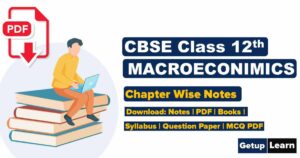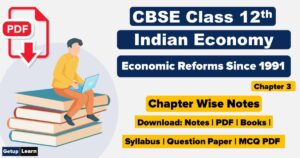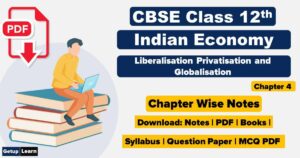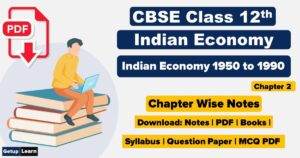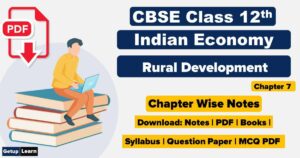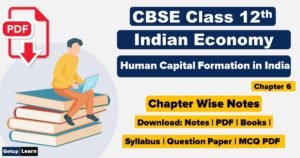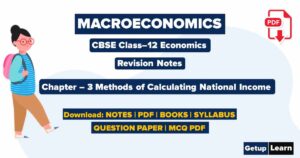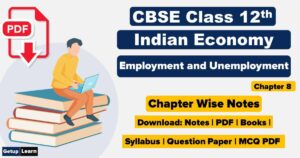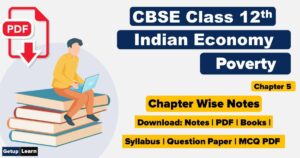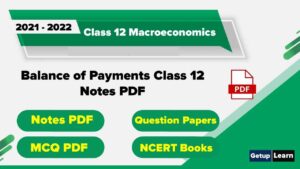Download Money and Banking Class 12 Notes PDF, Question papers, MCQ PDF, NCERT Books, and Syllabus free of cost in just minutes. We provide complete study material of money and banking Class 12 Notes.
This study material includes money and banking Class 12 Notes, previous year question paper class 12, Mcq Pdf, NCERT books, Latest syllabus by CBSE 2022-2023.
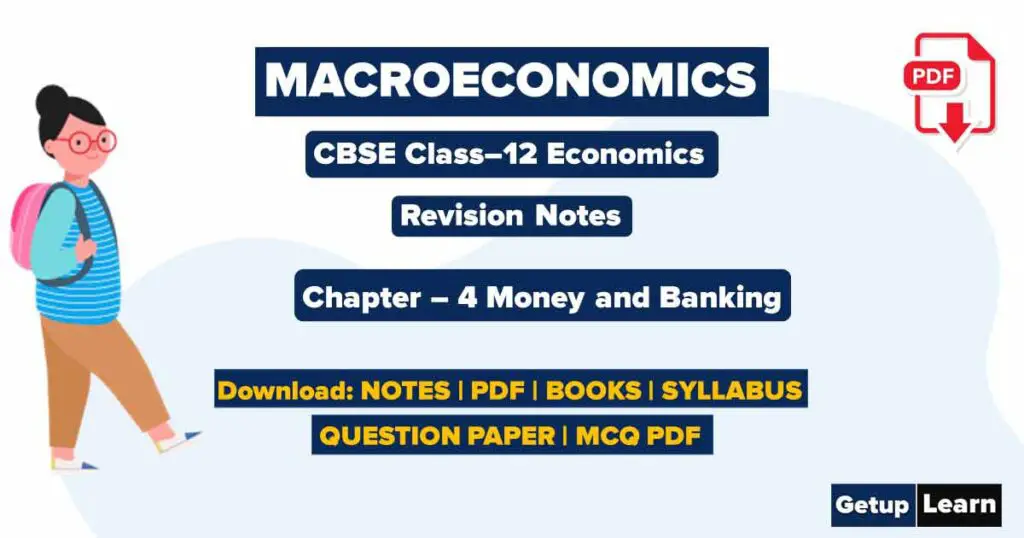
You can download money and banking notes PDF Class 12 the below article.
Table of Contents
- 1 Download Money and Banking Class 12 Notes PDF
- 2 Money and Banking Class 12 Notes PDF
- 3 Money and Banking Class 12 MCQ Questions PDF
- 4 Money and Banking Class 12 MCQ Questions and Answers PDF
- 5 Money and Banking Class 12 Questions and Answers PDF
- 6 Money and Banking Class 12 Important Questions PDF
- 7 Money and Banking Notes
- 8 Central Bank
- 9 FAQ Related to Money and Banking
Download Money and Banking Class 12 Notes PDF
This is a downloading table for money and banking class 12 notes pdf:
| Money and Banking Class 12 Notes | (HOW TO DOWNLOAD) |
| ????Money and Banking Class 12 Notes PDF | ????Download |
| ????Money and Banking Class 12 MCQ Questions PDF | ????Download |
| ????Money and Banking Class 12 MCQ Questions and Answers PDF | ????Download |
| ????Money and Banking Class 12 Questions and Answers PDF | ????Download |
| ????Money and Banking Class 12 Important Questions PDF | ????Download |
Money and Banking Class 12 Notes PDF
CBSE Class 12 Macroeconomics chapter 4 money and banking Notes PDF are made by research of last ten years NCERT question paper. Further, they are all designed with the latest CBSE guidelines 2022-2023, and only important topics are covered because of the high chances to appear in exams.
NCERT Class 12 Macroeconomics chapter 4 money and banking Class 12 Notes is very useful for students because it is necessary to understand all important questions and answer them in an efficient manner.
[su_button url=”https://drive.google.com/file/d/1NALhyMu6hK9Wcj43hzCfrs9n2z4KOFAf/view” target=”blank” style=”flat” wide=”yes” center=”yes” radius=”10″ text_shadow=”0px 0px 0px #ffffff” download=”https://drive.google.com/file/d/1NALhyMu6hK9Wcj43hzCfrs9n2z4KOFAf/view” id=”download”]Download PDF[/su_button]
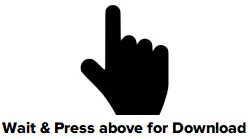
Download All: ????Macroeconomics Class 12 Notes PDF????
Download Class 12th Notes PDF
[su_spoiler title=”Macroeconomics Class 12 | Indian Economy Class 12” style=”fancy” icon=”plus-circle”]
Macroeconomics Class 12
Indian Economy Class 12
- Indian Economy on the Eve of Independence
- Indian Economy 1950 to 1990
- Economic Reforms Since 1991
- Liberalisation Privatisation and Globalisation
- Poverty
- Human Capital Formation in India
- Rural Development
- Employment and Unemployment
- Infrastructure
- Environment and Sustainable Development
- Comparative Development Experiences of India and Its Neighbours
[/su_spoiler]
With these money and banking notes pdf sample papers, students will have no problem making revision notes before exams and they don’t have to waste time making CBSE revision notes. You guys can download macroeconomics notes class 12 in just minutes. Money and Banking Notes Pdf notes are well structured and prepared based on CBSE latest syllabus class 12 2022-2023.
These NCERT macroeconomics notes chapter 4 money and banking Notes PDF for class 12 are well-defined and easy-to-understand concepts and include some practical questions for practice purposes.
We provided CBSE notes in pdf format for Students and they can use sample papers for preparing for the CBSE board exam 2022-202. CBSE Class 12 macroeconomics chapter 4 money and banking Notes is very important for exam perspectives because it is a practical question chapter, not theory-based chapter. And for exam perspective this important chapter because it has higher marks weightage in macroeconomics.
With the help of CBSE revision notes students can revise for the exam. Class 12 macroeconomics Chapter 4 money and banking Notes are the best finest notes because these are prepared by very experienced teachers. Class 12 macroeconomics chapter 4 money and banking is made in very easy language which helps the students understand easily.
Money and Banking Class 12 MCQ Questions PDF
Below that you can download the money and banking class 12 MCQ questions pdf. We have covered all related MCQ’s money and banking class 12 MCQ questions in this pdf. You can practice all of them by these money and banking MCQ questions PDF.
Money and Banking Class 12 MCQ Questions and Answers PDF
Here are some of the money and banking class 12 mcq questions and answers pdf mentioned below. You can download money and banking class 12 MCQ pdf form. These are the most relevant MCQ questions and have a higher chance of appearing on exam papers.
Money and Banking Class 12 Questions and Answers PDF
Here we are providing money and banking class 12 questions and answers pdf and in this notes we have covered all Important Questions and Answers from Chapter 4 money and banking. Money and Banking notes of Economics Class 12 Important Questions are the best resource for students which helps in class 12 board exams.
Money and Banking Class 12 Important Questions PDF
This is the money and banking class 12 important questions pdf which we are providing for you. We have selected all those important questions from previous years’ question papers. If you learn the following money and banking class 12 important questions you don’t have to open your textbook again and by these questions, you score high in exams.
Money and Banking Notes
What is Money?
Money is any object or record that is generally accepted as payment for goods and services and repayment of debts in a given socio-economic context or country. The main functions of money are distinguished as a medium of exchange; a unit of account; a store of value; and, occasionally in the past, a standard of deferred payment. Any kind of object or secure verifiable record that fulfils these functions can be considered money.
Functions of Money
Primary Functions
- Medium of Exchange: It can be used in making payments for all transactions of goods and services.
- Measure Unit of value: It helps in measuring the value of goods and services. The value is usually called as price. After knowing the value of goods in single unit (price) exchanges become easy.
Secondary Functions
-
Standard of Deferred Payments: Deferred payments referred to those payments which are to be made in near future. Money acts as a standard deferred payment due to the following reasons: a) Value of money remains more or less constant compared to other commodities. b) Money has the merit of general acceptability. c) Money is more durable compare to other commodity.
- Store of Value: Money can be stored and does not lose value Money acts as a store of value due to the following reasons: a) It is easy and economical to store. b) Money has the merit of general acceptability. c) Value of money remains relatively constant.
Draw Backs of Barter System
These are the drawbacks of the barter system which are:
Medium of Exchange:
Medium of Exchange: Money has removed the major difficulty of the double coincidence of wants.
Measure of Value
Measure of value: Money has become a measuring rod to measure the value of goods and services and is expressed in terms of price.
Store of Value
Store of Value: It is very convenient, easy and economical to store the value and has got general acceptability which was lacking in the barter system.
Standard of Deferred Payments
Standard of Deferred Payments: Money has simplified the borrowing and lending of operations which were difficult under the barter system. It also encourages capital formation.
Money Supply
Money supply refers to the total volume of money held by the public at a particular point of time in an economy.
- M1=currency held by public + Demand deposits + other deposits with Reserve Bank of India.
- M2=M1+saving deposits with post office saving bank
- M3=M1+net time deposit with the bank
- M4=M3 + total deposits with post office saving bank excluding national saving certificate.
High Powered Money
High powered money: Refers to, currency with the public (notes +coins) and a cash reserve of banks.
Money Creation, Deposit Creation, Credit Creation by Commercial Bank
Let us understand the process of credit creation with the following example.
Suppose there is an initial deposit of Rs. 1000 and L.R.R. are 20% i.e., the banks have to keep Rs. 200 and lend Rs. 800/-. All the transactions are routed through banks. The borrower withdraws his Rs. 800/- for making payments which are routed through banks in the form of deposits account.
The Bank receives Rs. 800/- as deposit and keeps 20% of Rs.800/- i.e., Rs.160/- and lends Rs.640/-. Again the borrower uses this for payment which flows back into the banks thereby increasing the flow of deposits.
| Deposits (in Rs.) | Loans (in Rs.) | Cash Reserve Ratio (20%) | |
| Initial Deposit | 1000 | 800 | 200 |
| First-round | 800 | 640 | 160 |
| Second round | 640 | 512 | 128 |
| — | — | — | — |
| — | — | — | — |
| — | — | — | — |
| — | — | — | — |
| Total | 5000 | 4000 | 1000 |
Money Multiplier
Money Multiplier = 1/LRR. In the above example, LRR is 20% i.e., 0.2, so the money multiplier is equal to 1/0.2=5.
Why only a fraction of deposits is kept as Cash Reserve? a) All depositors do not withdraw the money at the same time. b) There is a constant flow of new deposits into the banks.
Central Bank
Central Bank: An apex body that controls, operates, regulates and directs the entire banking and monetary structure of the country
Functions of Central Bank
These are the functions of the central bank given below:
- Currency Authority or Bank of Issue
- Banker to the Government
- Banker’s Bank and Supervisor
- Controller of Money Supply and Credit
- Custodian of Foreign Exchange Reserves
Currency Authority or Bank of Issue
The central bank is the sole authority to issue currency in the country. Central Bank is obliged to back the currency with assets of equal value (usually gold coins, gold bullions, foreign securities etc.,) Advantages of sole authority of note issue:
- Uniformity in note circulation.
- Better supervision and control.
- It is easy to control credit.
- Ensures public faith.
- Stabilization of internal and external value of currency.
Banker to the Government
As a banker, it carries out all banking business of the Government and maintains a current account for keeping cash balances of the government. Accepts receipts and makes payments for the government. It also gives loans and Advances to the government.
Banker’s Bank and Supervisor
Acts as a banker to other banks in the country:
- Custodian of cash reserves:- Commercial banks must keep a certain proportion of cash reserves with the central bank (CRR).
- Lender of last resort: – When commercial banks fail to need their financial requirements from other sources, they approach Central Bank which gives loans and advances.
- Clearing house: – Since the Central Bank holds the cash reserves of commercial banks it is easier and more convenient to act as clearing house of commercial banks.
Controller of Money Supply and Credit
Central Bank or RBI plays an important role during times of economic fluctuations. It influences the money supply through quantitative and qualitative instruments. The former refers to the volume of credit and the latter refers to regulating the direction of credit.
Custodian of Foreign Exchange Reserves
Another important function of the Central Bank is the custodian of foreign exchange reserves. Central Bank acts as custodian of the country’s stock of gold and foreign exchange reserves. It helps in stabilizing the external value of money and maintaining a favourable balance of payments in the economy.
Quantitative Instruments
Bank Rate Policy
It refers to the rate at which the central bank lends money to commercial banks as a lender of the last resort. Central Bank increases the bank rate during inflation (excess demand) and reduces the same in times of deflation (deficient demand).
Open Market Operations
It refers to the buying and selling of securities by the Central Bank from/ to the public and commercial banks. It sells government securities during inflation/excess demand and buys the securities during deflation/deficient demand.
Legal Reserve Ratio
R.B.I. can influence the credit creation power of commercial banks by making changes in CRR and SLR.
- Cash Reserve Ratio (CRR): It refers to the minimum percentage of net demand and time liabilities to be kept by commercial banks with central bank. Reserve Bank increases CRR during inflation and decreases the same during deflation.
- Statutory Liquidity Ratio (SLR): It refers to minimum percentage of net demand and time liabilities which commercial banks required to maintain with themselves. SLR is increased during inflation or excess demand and decreased during deflation or deficient demand.
Qualitative Instruments
Margin Requirements
Margin Requirements: It is the difference between the amount of loan and the market value of the security offered by the borrower against the loan. Margin requirements are increased during inflation and decreased during deflation.
Moral Suasion
Moral Suasion: It is a combination of persuasion and pressure that the Central Bank applies to other banks in order to get them act in a manner in line with its policy.
Selective Credit Controls
Selective Credit Controls: Central Bank gives direction to other banks to give or not to give credit for certain purposes to particular sectors.
What is money and banking?
Money is a thing that is commonly accepted as a medium of exchange. Banking is Banks are financial institution that accepts deposits from the public and provide loans facilities for investment with the aim of earning profit.
What are the 4 types of money?
These are three types of money Fiat Money, Fiduciary Money, Full Bodied Money, Credit Money, Digital money.
What is called banking?
Banks are financial institution who accepts deposits from the public and provide loans facilities for investment with the aim of earning profit.



